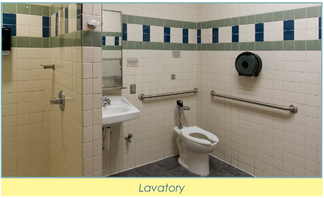
Ken Newell
Departments and municipalities across the nation are addressing the issue of sustainable design. Most are still developing goals and guidelines for their new or renovated facilities. Based on their experiences of incorporating sustainable design on recent projects, some departments and municipalities are re-evaluating the requirements that they have put in place over the past decade. Before we consider an example of one reevaluated approach, let’s discuss what sustainable design has come to mean in the design and construction industry.
Departments and municipalities across the nation are addressing the issue of sustainable design. Most are still developing goals and guidelines for their new or renovated facilities. Based on their experiences of incorporating sustainable design on recent projects, some departments and municipalities are re-evaluating the requirements that they have put in place over the past decade. Before we consider an example of one reevaluated approach, let’s discuss what sustainable design has come to mean in the design and construction industry. The Webster’s Dictionary states that “sustainable” means something that can “withstand or endure”…a pretty generic definition. For the purposes of the green building conversation, sustainable design is the design and construction practices that significantly reduce or eliminate the negative impact of buildings on the environment and occupants. Certainly, we can all agree that sustainable design is a worthy goal. It has been said that good design is inherently sustainable design.
Over the centuries there have been great examples of structures that were planned, designed, and constructed to be sustainable. Many of these we still enjoy in the 21st century. The White House, the Biltmore, and Fort Sumter are good examples. Today, sustainable design implies that very specific and predetermined steps have been taken to insure a “sustainable” result. The
most popular process developed to achieve a measurable level of sustainable design is LEED.
What is LEED?
By now it is likely that most of you have been exposed to some knowledge or explanation of the LEED process. As a means of brief introduction, LEED stands for Leadership in Energy and Environmental Design and is usually a voluntary rating system administered
by the US Green Building Council (USGBC), a nonprofit, non-government organization. I say “usually voluntary” because, while the USGBC does not impose LEED requirements on any entity, many Fire Departments find LEED required due to adopted policies by their governing municipalities or boards. LEED identifies several categories to consider with
sustainable design, including site, water, energy, indoor environmental quality, etc. The levels of LEED certification are achieved through points, with a minimal level of Certified, to a maximum level of Platinum. There are other less popular programs used to pursue levels of sustainable design, such as Green Globes and several state guidelines like the Florida Green Building Council (FGBC). However, LEED remains the most recognized program for achieving sustainable design. As previously mentioned many governmental units and organizations are adopting LEED as a requirement for all new projects. Any professional design firm you work with should be committed to meeting the goals of general sustainability design as well as any sustainable guidelines that the department or municipality may require. I have been involved in numerous fire
By Ken Newell
Sustainable Stations
“Without the Plaque”
This Chief advises every Fire Department to work with their Architectural designer to select
the best sustainable design to enhance firefighter’s lives and not add to their duties.
Bike Racks are a sustainable feature not many people consider Sustainable Stations “Without the Plaque”
Stewart Cooper Newell Architects copyright 2020 © 3
station design projects that have achieved high levels of certification in LEED as well as
the other sustainable design programs that exist. The most prominent reason that some agencies have reevaluated their requirements for sustainable design certification is the cost. Over the years, some well intended proponents of LEED or similar programs have said that “certification should not increase your design or construction costs”. But for most
designers and builders, the materials, time and work effort required increases costs significantly when sustainable certification is required. These costs are passed along to the client in the form of increased design fees and construction costs. In the future, these programs may be so common that the cost increases will diminish, but they are not likely to disappear.
A Growing Trend
As we have continually provided design services for LEED certified station projects, we have noticed a growing trend among departments and municipalities – that is to pursue green buildings without certification…sustainable stations “without the plaque”. The recently completed, award-winning Carrboro Station No 2 is one example of how a North Carolina town re-evaluated their sustainable design goals early in the design process.
Station No 2 is the product of progressive planning by the Town of Carrboro. Realizing that energy efficient, sustainable design was quickly becoming a community goal, the Town decided to utilize the new station project to create a benchmark for sustainability for future capital projects. Prior to selecting our firm as the Architect of Record, the Town of Carrboro set the goal of targeting a LEED Silver certification for their project. As the
design process was initiated, all of the prerequisite steps were taken that would eventually result in LEED Silver. As the Town of Carrboro learned about the necessary registrations and administrative steps that were required for certification, but that do not add to the sustainable design elements in the facility, they realized that there was a cost associated with pursuing and achieving certification that would not yield “pay-back” per se.
Sustainable Stations “Without the Plaque”
continued...
The Town of Carrboro, NC Fire Station No. 2
Water Reclamation System
recycles rain that fall on the roof
As part of our standard cost estimating procedures, we identified that registering the project with USGBC, providing the minimal design modeling required by USGBC, and performing the required building systems commissioning necessary for LEED Silver would add approximately an additional $60,000 to the project.
The Cost Savings
The Town decided that if constructing a sustainable fire station was truly their goal, their preference would be to use that sixty-thousand dollars that would be required to “have a LEED Silver plaque on the wall” towards incorporating even more sustainable design features into the project. The result is an award winning station designed to be “equivalent” to a LEED Silver certified facility. In other words, the Town of Carrboro got the LEED Silver Sustainable design it required, without paying the sixty-thousand dollars for the certification – a sustainable Fire Station (or Police Station for that matter) without the Plaque! Station No 2 is located on a very narrow 1.75 acre site, which is populated by several very old specimen magnolia trees that are critical to the local ecosystem. Through painstaking design and great care during construction, the site was developed to provide effective access to and from the station while preserving the trees and the majority of the
existing vegetation. These constraints also reduced the build-able footprint of the station significantly. The floor plan was designed to respond to those constraints, allowing
them to help determine the form of the building. The station plan was designed to minimize southern sun exposure, as well as create a functional layout that allows for efficiency of the heating and cooling systems. Some of the sustainable design alternatives include rainwater reclamation and reuse, a solar thermal hot water system, water saving plumbing fixtures, energy efficient HVAC systems, recycled materials, low VOC finishes, window shading devices that keeps direct summer sunlight out of the station while
allowing extensive day-lighting and views, along with many other elements.
Sustainable Stations “Without the Plaque”
continued...
Solar roof panels and rain capture panels over patio An abundance of natural light is brought into the Fire Station by the placement of glass windows and doors.
Sustainable Stations “Without the Plaque”
Stewart Cooper Newell Architects copyright 2020 © 5
The station includes two drive-through apparatus bays with adjacent decontamination space, tool shop and storage areas. The crew has a watch room, triage, day-room, kitchen, dining and training rooms at their disposal. The residential area provides individual sleeping quarters for five, along with private lavatory facilities. A small police sub-station is also included with a separate entry. In 2012, Station No 2 was recognized by the Fire
Industry and Equipment Research Organization (FIERO), by winning a Merit award, which specifically honors the project’s sustainable design elements. In 2013, the project was recognized by Fire Chief Magazine’s annual Station Style Awards committee, by winning a Bronze award for the design of a satellite station. Chief Travis Crabtree, the Fire Chief at the time, says that the Fire Department is very pleased with the station and the results of the sustainable design effort. “We believe that the Town of Carrboro made a very
wise decision to use funds for a LEED plaque, to add more sustainable features to the station itself.” Chief Crabtree adds, “Station No 2 proves that a fire station can be designed to function well for fire fighting, while also excelling as a long-lasting, sustainable facility”. The Chief advises every Fire Department to work with their Architectural designer to select the best sustainable design elements to enhance firefighter’s lives and not add to their duties.
Conclusion
The bottom line is that the sustainable design process and elements you chose should provide clear pay-back of benefits and survive the rigorous use of firefighters. Whether your department is committed to a certified level, or can live without the plaque, sustainable design is good design and can be achieved by you project without an added
expense.
















